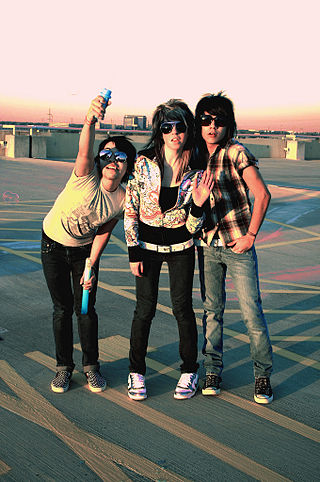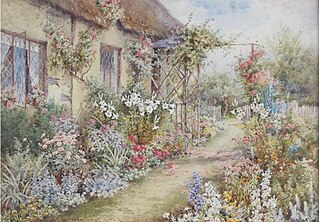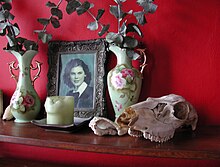
The scene subculture is a youth subculture that emerged during the early 2000s in the United States from the pre-existing emo subculture. The subculture became popular with adolescents from the mid 2000s to the early 2010s. Members of the scene subculture are referred to as scene kids, trendies, or scenesters. Scene fashion consists of skinny jeans, bright-coloured clothing, a signature hairstyle consisting of straight, flat hair with long fringes covering the forehead, and bright-coloured hair dye. Music genres associated with the scene subculture include metalcore, crunkcore, deathcore, electronic music, and pop punk.

"Pretty Boy Swag" is a song by American rapper Soulja Boy, released as the first single from his third studio album The DeAndre Way (2010). It features production from G5 Kids, who helped to write the song along with Soulja Boy.

Soft grunge was a fashion trend that originated on Tumblr around the late 2000s and early 2010s. Beginning as an outgrowth of the 2000s indie sleaze fashion trend but with a greater influence from the 1990s, particularly grunge fashion, the style began as a reaction against the glamor fitness culture which was dominant in popular culture at the time. It is characterized by its merger of cute and aggressive fashion hallmarks like chokers, tennis skirts, leather jackets and boots, flower crowns, distressed denim and pastel colors. Soft grunge reached its peak popularity around 2014, by which time it had been embraced by high fashion designers including Hedi Slimane and Jeremy Scott and been worn by celebrities including Charli XCX. Its internet-based merger of subculture, fashion and music made it one of the earliest examples of an internet aesthetic. In the early 2020s, the style experienced a minor resurgence due to videos posted on the video sharing application TikTok.

Femboy ( ), also spelled femboi, is a slang term for a male or non-binary individual who expresses themselves with traditionally feminine behaviours. As an internet aesthetic, this may be through the use of jewellery, wearing feminine clothing and makeup, or expressing feminine behavioural qualities. Femboy can be used as both a sexual and non-sexual term; it does not denote a specific sexual orientation or gender role, but instead marks a form of gender variance.

TikTok, whose mainland Chinese counterpart is Douyin, is a short-form video hosting service owned by ByteDance. It hosts user-submitted videos, which can range in duration from 3 seconds to 10 minutes.

Charli Grace D'Amelio is an American social media personality. She was a competitive dancer for over a decade before starting her social media career in 2019, when she began posting dance videos on the video-sharing platform TikTok. She quickly amassed a large following and subsequently became the most-followed creator on the platform in March 2020 until she was surpassed by Khaby Lame in June 2022. With over 151 million followers, she is the second-most-followed-person on TikTok, as of 2024.

E-girls and e-boys, sometimes collectively known as e-kids, are a youth subculture of Gen Z that emerged in the late 2010s, notably popularized by the video-sharing application TikTok. It is an evolution of emo, scene and mall goth fashion combined with Japanese and Korean street fashion.

Cottagecore is an internet aesthetic idealising rural life. Originally based on a rural European life, it was developed throughout the 2010s and was first named cottagecore on Tumblr in 2018. The aesthetic centres on traditional rural clothing, interior design, and crafts such as drawing, baking, and pottery, and is related to similar aesthetic movements such as grandmacore, goblincore, gnomecore and fairycore.
Cole Chase Hudson, known professionally as Huddy, is an American singer, actor, and social media personality, known for co-founding the TikTok collective the Hype House, and popularizing the e-boy fashion style and subculture. A 2020 article in Billboard Magazine rated him as one of the top 10 music influencers on TikTok that year, with over 30 million followers, and one of the most influential people on the platform. He has also been cited by Paper as an important figure in the 2020s pop punk revival.

Dark academia is an internet aesthetic and subculture concerned with higher education, the arts, and literature, or an idealised version thereof. The aesthetic centres on traditional educational clothing, interior design, activities such as writing and poetry, ancient art, and classic literature, as well as classical Greek and Collegiate Gothic architecture. The trend emerged on social media site Tumblr in 2015, before being popularised by adolescents and young adults in the late 2010s and early 2020s, particularly during the COVID-19 pandemic.

The fashions of the 2020s represent a departure from 2010s fashion and feature a nostalgia for older aesthetics. They have been largely inspired by styles of the early-to-mid-2000s, late 1990s, 1980s, 1970s, and 1960s. Early in the decade, several publications noted the shortened trend and nostalgia cycle in 2020s fashion.

Mall goths are a subculture that began in the late-1990s in the United States. Originating as a pejorative to describe people who dressed goth for the fashion rather than culture, it eventually developed its own culture based around nu metal, industrial metal, emo and the Hot Topic store chain. It has variously been described as a part of the goth subculture, as well as a separate subculture simply influenced by goth.
A straight flag or heterosexual flag is a pride flag intended to represent heterosexuality. Some straight flags represent straight pride, a conservative countermovement to gay pride. There is also the straight ally flag, which is intended to represent allyship by straight people with the LGBT community. Although there are many proposed straight flags, none of them enjoys broad consensus for usage today.

Indie sleaze was a fashion style popular in the United States and United Kingdom from approximately 2006 to 2012. Characterised by an affordable, messy and lethargic take on vintage fashion styles, especially the 1970s, the style was particularly popular amongst the hipster subculture and indie rock bands.
Soft Girl or Softie describes a youth subculture that emerged among female teenagers around mid-to late-2019. Soft girl is a fashion style and a lifestyle, popular among some young women on social media, based on a deliberately cutesy, feminine look with a girly girl attitude. Being a soft girl also may involve a tender, sweet, and sensitive personality.
An Internet aesthetic, also simply referred to as an aesthetic or microaesthetic, is a visual art style, sometimes accompanied by a fashion style, subculture, or music genre, that usually originates from the Internet or is popularized on it. Throughout the 2010s and 2020s, online aesthetics gained increasing popularity, specifically on social media platforms such as Tumblr, Pinterest, Instagram and TikTok, and often were used by people to express their individuality and creativity. They can also be used to create a sense of community and belonging among people who share the same interests. The term aesthetic has been described as being "totally divorced from its academic origins", and is commonly used as an adjective.

Goblin mode is a neologism for the rejection of societal expectations in a hedonistic manner without concern for one's self-image. While usage of the term dates back to 2009 with varying definitions, the term went viral in early 2022.
Corecore is an Internet aesthetic and artistic movement aiming to capture post–2020 sensibilities. A product of youth culture in the 2020s, the corecore aesthetic can largely be found on TikTok, where it juxtaposes various video clips while emotional music plays.
Light academia is an internet aesthetic and subculture, that emphasizes visually light aesthetics and positive themes, including optimism, joy, and friendship. Accordingly, light academia is often considered to be the visually and emotionally lighter counterpart to dark academia. The term light academia was coined on Tumblr in 2019 and gained popularity during the early 2020s.

Coquette aesthetic is a 2020s fashion trend that characterized by a mix of sweet, romantic, and sometimes playful elements and focuses on femininity through the use of clothes with lace, flounces, pastel colors, and bows, often draws inspiration from historical periods like the Victorian era and the 1950s, with a modern twist.















